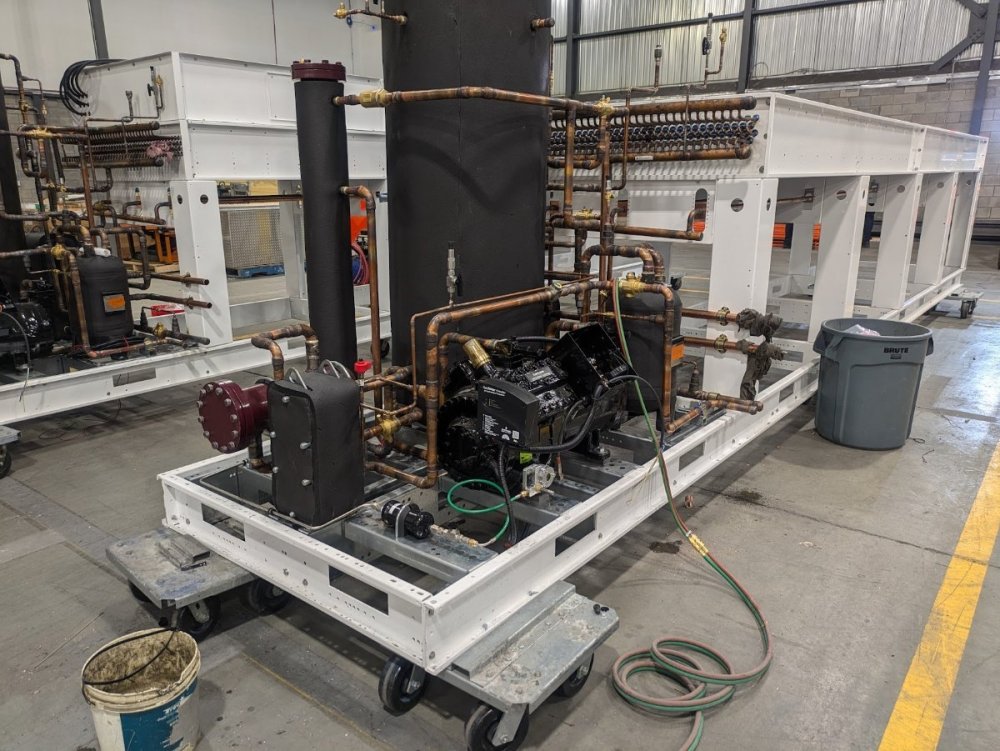Leaderboard
Popular Content
Showing content with the highest reputation on 05/14/25 in all areas
-
I personally think ecc isn't the biggest deal for homelabs. Easiest way to get ecc support is with modern ryzen. (I forget if older ryzen supports it)2 points
-
I would like to see an option of an one click full disk encryption at system setup (or disk/pool or per application setup). Then it should work like in the TrueNAS interface with a warning ⚠️ about the possibility to lose all data if the corresponding password/key is not stored properly and so on... It would be preferable to encrypt all the folders below automatically too, since the title “Full disk encryption ...".1 point
-
Hi Folks, This post will go over the basic requirements for running HexOS, then cover a few frequently asked questions. If you come across frequently asked questions that are not included in the main post please comment below! NOTE: Please keep comments here directly related to the post/FAQ itself. and create separate topics to discuss specific use cases and issues. Thanks! Updated 12/4/24 ---------------------------------------------------- Minimum Hardware Requirements: x86 compatible hardware (Intel or AMD) (HexOS is NOT ARM or RISC-V compatible) 64 bit Processor with 2+ cores 8GB or more of system memory 16GB boot SSD Larger is OK, but not necessary. 3+ storage drives recommended 2 storage drives is the current minimum. (Pools created with 2 drives are not expandable. See details below.) Single drive configurations are not supported at this time. Please visit https://hexos.com/early-access-faq for more info Also, please check out the roadmap web page for info on upcoming features; https://hexos.com/blog/the-road-to-10 ------------------------------------------------------- FAQ: Q: Can I install HexOS on a virtual machine? A: Yes. While HexOS is meant to be installed on physical hardware, it can be ran as a VM. Please see TrueNAS SCALE documentation for details on running TrueNAS as a VM. Q: can I install HexOS on a UGREEN or ASUSTOR NAS? A: Yes. To the best of my knowledge, UGREEN and ASUSTOR NAS devices all support installing 3rd party operating systems. Google "Installing TrueNAS on [insert brand name here] NAS" to find guides and forum posts with other users experiences. Q: Can I install HexOS on my old Synology NAS or Netgear Ready NAS? A: No. Unfortunately many consumer NAS solutions do not support installation of 3rd party operating systems. NOTE: It appears that some Ready NAS devices are capable of using 3rd party operating systems through advanced techniques, but the jury is out currently on exactly which models, and whether or not the hardware is performant enough for a good user experience. Q: Can I run HexOS on a Raspberry Pi or equivalent? A: No. Raspberry Pi devices are built using ARM processors. HexOS requires x86 hardware. Q: Can I start with only a few (3+) drives and expand later? A: Yes.You can add more drives of the same capacity to a pool to increase its available space. Q: Can I expand my storage pool if I started with only 2 drives? A: No. While OpenZFS has support for expanding a 2-device RAIDz1, that capability has not been enabled in TrueNAS SCALE. Q: Can I set up a storage pool using a single hard drive? A: No. Single drive configurations are not supported at this time This may change in the future, but either way it is discouraged due to single drive configurations being susceptible to data loss from hardware failure. Q: Can storage pools use drives with different capacities without loosing space? A: No. While mismatched drives can be used, in any one pool the maximum usable capacity per drive is limited by the size of the smallest drive in that pool. Example: A storage pool with 5x 256GB SSDs and 1x 250GB SSD will have the same usable capacity as a pool with 6x 250GB drives. Q: Can I change small drives our for larger ones to increase my storage pool's capacity? A: Yes. Drives can be exchanged one at a time to gradually copy all the data onto larger drives, Once all drives have been exchanged the pool's capacity will grow all at once. Example: Lets say we have a pool with 6x10TB drives in RAIDz1, and we swap those out one by one for six 20TB units. When the last 20 TB drive has been installed, and the pool has finished re-silvering (copying data to a drive to re-construct the pool) then the pool's total capacity will jump from ~50TB usable to ~100TB usable!1 point
-
1 point
-
Howdy ya'll, I'm pinormous. My interest in computers started back with RollerCoaster Tycoon, a game that could run on anything. I was soon puzzled why other games couldn't be played on my family computer, quickly learning that not all computers have the same capabilities. As my knowledge grew, I stumbled into the LimeWire era of data hoarding and never looked back. Over the next 7 years bigger hard drives were purchased then filled, external drives were acquired then subsequently filled, heard about Plex as a way to remotely access all my content, then I finally got serious about my addiction and bought an 8-bay NAS - giving me 34 TB of useable space. This will surely be enough, I told myself, there's no way I'll fill it up. 5 years later, I found out how much of a lie that was. So I'm now diving down a new rabbit hole of disk shelves and servers. If it's worth doing, it's worth overdoing; so I have a 28U rack that I'll be filling with networking, power management, and whatever else I can slap in there and explore. I have 2x24 bay shelves that, once populated, should net me around 900 TB of useable space. Surely, this will be enough space. There's no way I'll fill it up. I'm looking forward to the journey of learning new software and hardware that will enable this upgrade in the coming year, with HexOS hopefully making my first real move outside of Windows a simpler foray, leaving plenty of time to tinker more with networking. When I'm not learning-by-doing, I am frequently found playing factory or driving games. When I'm not off the clock, I travel the US as a longhaul truck driver (which piqued my interest after putting hundreds of hours in ATS and ETS2), so having my own personal Netflix is a real saving grace.1 point
-
I'm pretty sure this is incorrect please refer to this thread on reddit https://www.reddit.com/r/HomeServer/comments/18znvaa/ryzen_cpus_support_ecc_memory/ yup it is, you can refer to pcpartpicker and use it's ecc toggle to narrow down ecc compatible gear but you will more than likely have to find the motherboard 2nd hand as with everything its a cost vs safety preference on your end. Its kinda like asking do i need raid 6 or is raid 5 good enough. I might think raid 5 is good enough but you might think raid 6 is a must for safety. However for more in depth info to help you decide if you need ecc feel free to refer to this following post. https://www.reddit.com/r/truenas/comments/10sr1zv/comment/j7394el/?utm_source=share&utm_medium=web3x&utm_name=web3xcss&utm_term=1&utm_content=share_button1 point
-
I recently used the F6-424 (which barring the number of bays should be the same I think), it was pretty easy overall. I updated the ram and added an NVMe M.2 drive to install HexOS onto. Here are some things to note or consider: -There is an issue with with some of the BIOS settings for the Terramaster and how it interacts with TrueNAS/HexOS, and after changing some settings I was able to solve those issues and it seems stable. (though its only been a couple days, but the rolling restarts no longer happen) Here is a link concerning the settings in the BIOS that should be changed from someone smarter than I: -As many guides/ videos point out, you will need a low profile USB imaged with HexOS to replace an existing USB that can be accessed by taking the right side of the case off, and removing the board under it, where the memory and M.2 slots are, it is located on the underside of that board. -It was recommended that after HexOS is installed to shut down the system and remove that USB because there is a tendency for the system to occasionally attempt to boot from it after install which can increase start up times for your server. I saw a video claiming that you could use the exterior USB and alternatively get to the BIOS to change the boot order, but most people said that it didn't work that way for whatever reason and you would want to remove the USB anyways. -During this process it was recommended to update the RAM as TrueNAS, and I imagine HexOS by proxy, will take advantage of it. This is my first NAS, and though I haven't done anything beyond using it as storage/ backup thus far, I found the hardware easy to work with and if you know to change the BIOS stuff indicated in the linked post then it seems to run fine. I will say this is not the most cost efficient way to have a NAS and it comes with the drawback of giving up some ability to upgrade in the future, but if your looking for a compact solution this works well and though I can't say that Terramasters software is great, I have seen people recommend their hardware. I hope this helps.1 point
-
I don't really know how easy difficult this would be.. but: It would be nice if you could make a hexos intergration for HA. Could be just monitoring, or could be basic actions too. But would be quite cool and nice1 point
-
I am Dylan, first of his name. I possess the power hardware, Linux and networking. I seek the simplicity of HexOS to ease the management of my digital realm. While I am not an immortal, if I am successful, my data will be. Go in peace.1 point
-
Hi everyone ! My name is Jeremie (or Jérémie your lanfuage use the little thing over the 2 e) I Liver In Beloeil, small city in Quebec provincem Canada, about 20 minute ,without traffic, from Montréal. I've been interested in computer science since I was about 12 or 13yo from my brother that was already working in a computer store that offer IT service... nowaday I dis try myself in a IT carreer but I found out I Need to work more from my hand than behind a computer screen... I Work for a HVAC company to do piping on CO2 Machine... (I'll include a picture of what I do) I still enjoy computer thing but only for my own need 😉1 point







